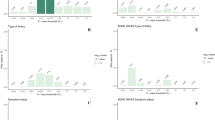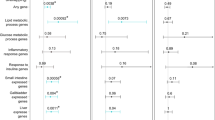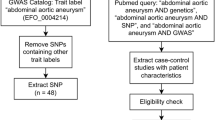Abstract
Male gender and family history are risk factors for abdominal aortic aneurysm (AAA). We hypothesized that genes involved in sex hormones might be important in AAA. We investigated the association of aortic diameter with single-nucleotide polymorphisms (SNPs) in genes determining circulating sex hormones and their action. We genotyped 74 tagging SNPs across four genes (steroid 5α reductase, subfamily A, polypeptide 1 (SRD5A1), cytochrome P450, family 19, subfamily A, polypeptide 1 (CYP19A1), androgen receptor (AR) and estrogen receptor 2 (ESR2)) related to sex hormone production and action in 1711 men, 640 of whom had an AAA. One genotype was also assessed in an independent cohort of 782 men, of whom 513 had large AAAs. Associations were assessed adjusting for other risk factors for AAA. One SNP in CYP19A1 was strongly associated with aortic diameter. Subjects who had the rare homozygote genotype (TT) for CYP19A1g.49412370C>T (SNP ID rs1961177), had an increased aortic diameter (coefficient 5.058, SE 1.394, P=0.0003, under a recessive model). This SNP was not associated with aortic diameter in an independent cohort, which included patients with larger AAAs. Our findings do not support an important role of genetic polymorphisms in genes determining sex hormones in aortic dilatation in men. The association of one SNP in CYPA9A1 with small but not large AAA may suggest differences between AAA formation and progression. This SNP warrants further investigation in another large population, including patients with small AAAs.
Similar content being viewed by others
Introduction
Abdominal aortic aneurysm (AAA) primarily affects men, with population-screening studies demonstrating an increased prevalence of approximately fivefold compared with women.1 Currently, the reasons for the male propensity for AAA are not known, but maybe linked to sex hormones, as in experimental models androgens have been positively linked to aortic dilatation.2 The production, metabolism and response to sex hormones are controlled by an array of enzymes and receptors, including steroid 5α reductase, aromatase (estrogen synthetase), androgen and estrogen receptors.3, 4 Steroid 5α reductase enzymes are responsible for the conversion of testosterone to the more potent androgen dihydrotestosterone.3 Aromatase (estrogen synthetase) is a cytochrome P450 enzyme that converts androgen precursor steroids to estrogens.4 The responses to circulating sex hormones are determined by the androgen and estrogen receptors. Genetic factors appear to have an important role in the production, metabolism and response to male sex hormones, and therefore maybe relevant to AAA, which has been shown to have inherited risk factors.5, 6 We selected four genes important in the production, metabolism and response to sex hormones to examine the association of genetic polymorphisms with aortic dilatation. We hypothesized that single-nucleotide polymorphisms (SNPs) in the steroid 5α reductase, subfamily A, polypeptide 1 (SRD5A1), cytochrome P450, family 19, subfamily A, polypeptide 1 (CYP19A1), androgen receptor (AR) and estrogen receptor 2 (ESR2) genes were associated with aortic dilatation and examined this within subset of the Health In Men Study (HIMS). We attempted to replicate any positive associations in an independent cohort from New Zealand.
Subjects and methods
Study design and subjects
HIMS consists of a cohort of men who originally participated in a trial of screening for AAA and has been previously described in detail.7, 8 For the current study, genotyping was undertaken in all men with AAAs from whom DNA was available (n=640) and 1071 randomly selected age-matched men without an AAA were taken as controls. Any SNPs found to be significantly associated with aortic diameter were further assessed in an independent cohort of subjects from New Zealand.9 These subjects included 513 men with large AAAs (80% had undergone aortic repair) and 269 healthy elderly men from the same region of Otago. All subjects included in both cohorts had undergone abdominal ultrasound. Ultrasound reproducibility was assessed during subject recruitment and 95% confidence intervals were <3 mm.9 The definitions of clinical risk factors such as hypertension, dyslipidemia, diabetes, coronary heart disease and waist-to-hip ratio were as previously described.7
Genotyping
The Haploview software package (http://sourceforge.net) was used to define the linkage disequilibrium blocks and to choose tagging SNPs within the location of SRD5A1 (n=14), CYP19A1 (n=39), AR (n=5) and ESR2 (n=16) genes using HapMap Phase II data utilizing a pairwise approach (minor allele frequency >5% and r2>0.8).10 Regions analyzed included the entire gene, plus additional sequences 10 kb upstream and downstream of the gene. With this approach, 100% of the variation in the genes was captured. Genotyping on the HIMS subjects was carried out using the Illumina Golden Gate assay on an Illumina BeadLab System at University of Western Australia. Genotype calls were made using Bead Studio Genotyping Module software package Version 3.1 (Illumina, San Diego, CA, USA). Monoallelic SNPs and those with genotyping efficiency <15% were excluded. As a result, findings for SRD5A1g.10386C>G (SNP ID rs4702379), SRD5A1g.720102C>T (SNP ID rs6872996), CYP19A1g.1667A>C (SNP ID rs2445768), CYP19A1g.16698C>T (SNP ID rs8025374), AR g.98970A>G (SNP ID rs2361634) and ESR2g.63762130G>T (SNP ID rs1152583) were excluded. Genotyping efficiency for the other 68 SNPs was between 97 and 100%. Genotyping in the New Zealand cohort was carried out using polymerase chain reaction as previously described.9
Statistical analysis
Hardy–Weinberg equilibrium was tested on a contingency table of observed verses predicted phenotype frequencies using a modified Markov-chain random-walk algorithm. To test our hypotheses, we investigated the association of genotyped SNPs and aortic diameter using linear regression adjusting for other risk factors for AAA (age, smoking, coronary heart disease, dyslipidemia, hypertension, diabetes, waist-to-hip ratio). Each of the bi-allelic SNPs was coded into three genotype classes and analyzed under codominant models (0=major allele homozygote, 1=heterozygote, 2=minor allele homozygote). Any significant codominant models were explored further (dominant and recessive models) to determine the best-fitting model using Akaiki information criteria. Haplotype frequencies were estimated from unphased genotype data using an expectation maximization algorithm under the assumption of Hardy–Weinberg equilibrium. Haplotypes were associated with aortic diameter using a generalized linear recessive model based on the initial genotyping results. Computations were undertaken using SimHap v1.0.2 (http://www.genepi.org.au/simhap.html) and SSPS 14.0 (SPSS Inc., Chicago, IL, USA). Genotypes associated with aortic diameter within the HIMS at a Bonferroni corrected P-value of <0.0007 (based on the 74 SNPs assessed) were examined in a second independent cohort.
Results
Association of genotypes with aortic diameter in the HIMS subjects
Genotyping was carried out in 1711 HIMS subjects of whom 640 (37%) had an AAA (Table 1). Out of 74, 68 (92%) SNPs passed quality assessments, were in Hardy–Weinberg equilibrium in controls, and therefore were assessed for association with aortic diameter. One SNP in CYP19A1 (CYP19A1g.49412370C>T; SNP ID rs1961177) was independently associated with aortic diameter in HIMS subjects (Supplementary Table). Median aortic diameters were 24.2 (interquartile range 21.1–31.3), 24.5 (inter-quartile range 21.1–32.7) and 30.6 mm (21.9–40.0) for men with CC (n=1317), TC (n=329) and TT (n=32) genotypes. CYP19A1g.49412370C>T (SNP ID rs1961177) was independently associated with aortic diameter under a recessive model (coefficient 5.058, SE 1.394, P=0.0003), including Bonferroni correction for multiple testing.
Haplotype analysis in the HIMS subjects
A total of 14 linkage dysequilibrium blocks were identified within the CYP19A1 gene using HapMap Phase II data (Figure 1). We assessed the association of haplotype combination from these different blocks with aortic diameter in HIMS subjects. Four haplotypes were demonstrated to be significantly associated with aortic diameter, after adjusting for other risk factors and multiple testing (Table 2). In particular the relative common haplotype CTT defined by the g.49386747C>G (SNP ID rs17523922), g.49394252C>T (SNP ID rs3751591) and g.49412370C>T (SNP ID rs1961177), which was present in 10% of men, P=0.0001 (Table 2).
Genotyping in the New Zealand men
We further examined g.49412370C>T (SNP ID rs1961177) in an independent cohort of 782 men from Otago, 513 (66%) of whom had an AAA. The patients with AAA in the New Zealand sample had a mean diameter of just under 6 cm, compared with <4 cm for the Western Australian men (Table 1). CYP19A1g.49412370C>T (SNP ID rs1961177) was not associated with aortic diameter in the New Zealand subjects (coefficient 0.076, SE 0.284, P=0.788).
Discussion
To our knowledge, this is the first published report examining the association of polymorphisms in genes determining circulating sex hormones and aortic diameter. As male gender is an important risk factor for AAA, we hypothesized that polymorphisms in four genes important in the production and action of sex hormones would be associated with aortic dilatation. One SNP within intron 1 of CYP19A1 was strongly associated with aortic diameter within the HIMS cohort, which included patients with small AAAs. The importance of this genetic locus in aortic dilatation was further supported by further analysis, which identified a haplotype, including this SNP as highly associated with aortic diameter in HIMS subjects. This genetic variation within CYP19A1 was not, however, associated with aortic diameter in the New Zealand subjects in which patients had much larger AAAs. Given the large number of SNPs examined and the lack of replication, our findings do not support a consistent association between polymorphisms in these genes and aortic diameter in men. Our findings do not, however, rule out a role of the one SNP highlighted in this study in early stage AAA formation in which different mechanisms may be involved compared with later-stage aneurysm progression. Also, our study did not examine all genes involved in sex hormone production and functions such as that of encoding estrogen receptor 1. The assessment of the SNP in CYP19A1 in another population screened for AAA in which aortic diameter and risk factors have been carefully assessed would be worthwhile when such a group becomes available.
References
Singh K, Bønaa KH, Jacobsen BK, Bjørk L, Solberg S : Prevalence of and risk factors for abdominal aortic aneurysms in a population-based study: The Tromsø Study. Am J Epidemiol 2001; 154: 236–244.
Henriques TA, Huang J, D’Souza SS, Daugherty A, Cassis LA : Orchidectomy, but not ovariectomy, regulates angiotensin II-induced vascular diseases in apolipoprotein E-deficient mice. Endocrinology 2004; 145: 3866–3872.
Ellis JA, Panagiotopoulos S, Akdeniz A, Jerums G, Harrap SB : Androgenic correlates of genetic variation in the gene encoding 5alpha-reductase type 1. J Hum Genet 2005; 50: 534–537.
Simpson ER, Michael MD, Agarwal VR, Hinshelwood MM, Bulun SE, Zhao Y : Cytochromes P450 11: expression of the CYP19 (aromatase) gene: an unusual case of alternative promoter usage. FASEB J 1997; 11: 29–36.
Meikle AW, Stringham JD, Bishop DT, West DW : Quantitating genetic and nongenetic factors influencing androgen production and clearance rates in men. J Clin Endocrinol Metab 1988; 67: 104–109.
Golledge J, Muller J, Daugherty A, Norman P : Abdominal aortic aneurysm: pathogenesis and implications for management. Arterioscler Thromb Vasc Biol 2006; 26: 2605–2613.
Golledge J, Clancy P, Jamrozik K, Norman PE : Obesity, adipokines, and abdominal aortic aneurysm: health in men study. Circulation 2007; 116: 2275–2279.
Norman P, Spencer CA, Lawrence-Brown MM, Jamrozik K : C-reactive protein levels and the expansion of screen-detected abdominal aortic aneurysms in men. Circulation 2004; 110: 862–866.
Jones GT, Thompson AR, van Bockxmeer FM et al: Angiotensin II type 1 receptor 1166C polymorphism is associated with abdominal aortic aneurysm in three independent cohorts. Arterioscler Thromb Vasc Biol 2008; 28: 764–770.
Barrett JC, Fry B, Maller J, Daly MJ : Haploview: analysis and visualization of LD and haplotype maps. Bioinformatics 2005; 21: 263–265.
Acknowledgements
We thank the participants and staff involved in the Western Australian AAA Screening Study and Health In Men Study. Funding from the NIH, USA (RO1 HL080010-01), National Health and Medical Research Council (540404) and James Cook University, Australia supported this work.
Author information
Authors and Affiliations
Corresponding author
Ethics declarations
Competing interests
JG and PEN hold Practitioner Fellowships from the National Health and Medical Research Council, Australia (431503 and 435805). JG holds a Senior Clinical Research Fellowship from the Queensland Government.
Additional information
Supplementary Information accompanies the paper on European Journal of Human Genetics website
Supplementary information
Rights and permissions
About this article
Cite this article
Golledge, J., Biros, E., Warrington, N. et al. A population-based study of polymorphisms in genes related to sex hormones and abdominal aortic aneurysm. Eur J Hum Genet 19, 363–366 (2011). https://doi.org/10.1038/ejhg.2010.182
Received:
Revised:
Accepted:
Published:
Issue Date:
DOI: https://doi.org/10.1038/ejhg.2010.182




